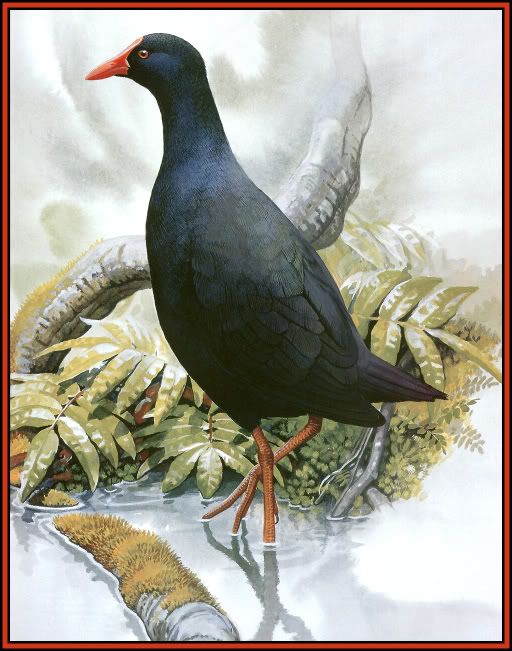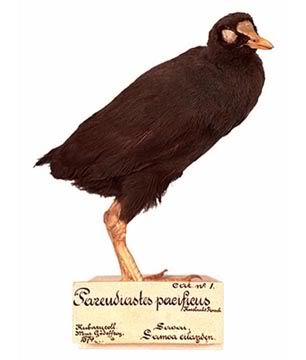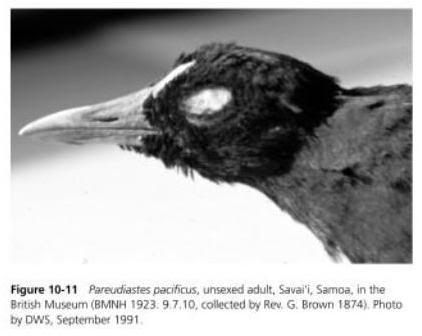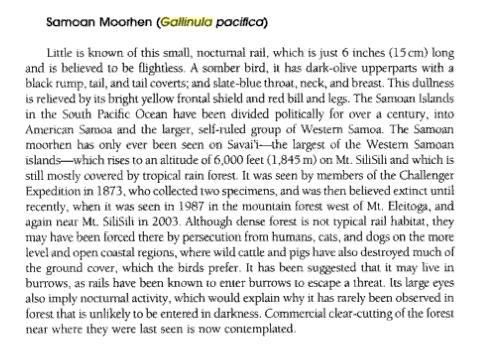Deleted
Deleted Member
Posts: 0
|
Post by Deleted on May 12, 2005 9:02:47 GMT
Hi ! I prefer the name Pareudiastes pacificus, because this bird is quite different from other Gallinula species.  Bye Alex |
|
|
|
Post by another specialist on Jun 14, 2005 10:29:44 GMT
Common Name/s SAMOAN MOORHEN (E) Justification This species has not been seen since 1873, and it may have been severely impacted by introduced cats, rats, pigs and dogs, compounded by hunting. However, it probably remains extant because extensive habitat remains, the species may be nocturnal and hence hard to record, and there were unconfirmed reports in 1987 and 2003. Any remaining population is likely to be tiny, and for these reasons it is treated as Critically Endangered. www.iucnredlist.org/search/details.php?species=8864 |
|
|
|
Post by another specialist on Jun 14, 2005 10:30:59 GMT
Family/Sub-family RALLIDAE Species name author (Hartlaub and Finsch, 1871) Taxonomic source(s) Sibley and Monroe (1990, 1993) Identification 25 cm. Medium-sized, flightless rail. Dark blueish-slate head, neck and breast. Very dark olive-brown upperparts, tinged greenish. Black rump to tail. Yellow bill and frontal shield. Red legs. Similar spp. Half-grown feral chickens have dark bills and no frontal shield. Juvenile Purple Swamphen Porphyrio porphyrio is much the same size and colour, but with much longer legs and toes. Population estimate Population trend Range estimate (breeding/resident) Country endemic? <50 unknown - Yes Range & population Gallinula pacifica is endemic to Savai`i, Samoa, where it was last recorded in 18736. In 1987 there were two possible sightings in upland forest west of Mt Elietoga3, and in October 2003 a possible sighting of two individuals was made at 990 m on Mount Sili Sili9. Ecology It is restricted to primary montane forest and most probably feeds on invertebrates, including insects. It may dig or live in burrows. One nest is described, found on the ground, constructed of a few twigs and some grass, and containing two eggs3,5,8. It has exceptionally large eyes and may thus be nocturnal8. Threats Cats, rats, pigs and dogs have no doubt contributed to its disappearance, and hunting may also have been a factor as it was formerly a favoured food of the human population3,8. Slash-and-burn cultivation threatens remaining areas of upland forest on Savai`i, as farmers use forestry roads from heavily logged lowland forests to gain access to formerly inaccessible land3. Wild cattle and pigs have browsed the understorey and ground-cover along the main range3. In 2000, attempts were being made by sawmill operators to clear-fell the area south of Aopo village, the site where this species was last seen2. Conservation measures underway A proposal is being developed to conduct surveys in Savai`i4. Conservation measures proposed Urgently conduct a survey to find this species and assess its status and conservation needs7. Protect foothill and upland forest for this and other species in north-west Savai`i1. Train local people to do bird surveys, generally involve the community and improve awareness of the species4,7. Reconnoitre field sites for the study of this and other threatened species on the island4. References 1. Beichle (in prep.). 2. U. Beichle in litt. (2000). 3. Bellingham and Davis (1988). 4. H. Freifeld in litt. (1999). 5. Pratt et al. (1987). 6. Ripley (1977). 7. SPREP (1999). 8. Taylor and van Perlo (1998). 9. D. Hobcroft in litt. (2003). www.birdlife.org/datazone/search/species_search.html?action=SpcHTMDetails.asp&sid=2933&m=0www.birdlife.org/datazone/search/species_search.html?action=SpcHTMDetails.asp&sid=2933&m=1 |
|
|
|
Post by another specialist on Jun 14, 2005 10:32:13 GMT
|
|
|
|
Post by another specialist on Jun 16, 2005 13:44:03 GMT
Possible sighting of long lost rail 16-10-2003 A birding tour group has gained a brief glimpse of a possible Samoan Moorhen Gallinula pacifica - a species that was last recorded with certainty in 1873. On 5 October 2003, Dion Hobcroft was leading a Victor Emanuel Nature Tour group of seven participants on the Samoan island of Savaii. The group were making their way along a narrow forest trail on Mount Sili Sili, accessed via Aopo Village. Just below an altitude of 1,000 metres, a distinctive low deep gulping call, described as "ooh-ooh-ooh", was heard. Less than five feet from the group, two medium-sized all dark, blackish forest rails were flushed. Only Dion Hobcroft and one other member of the group briefly saw the birds as they ran quickly off. "I have no personal doubt that this was an encounter with the presumed extinct Samoan Moorhen. The distinctive vocalisation was unlike any call I have heard from Buff-banded Rail, Purple Swamphen or feral Red Junglefowl in over twenty years of regular field experience with these taxa. The size, shape, colour and behaviour would appear compatible with our limited knowledge of this poorly known species." —Dion Hobcroft The last definite record was in 1873, and some people have suggested the species may be extinct. However, the Samoan Moorhen is currently classified by BirdLife as Critically Endangered because extensive habitat remains, it may be nocturnal and hence hard to record, and there were unconfirmed reports of the species in 1987. There is also the tantalising possibility that this latest sighting could have been of a previously unrecorded forest rail species. What is clear however is that further follow-up surveys on Savaii, where little ornithological work has been carried out, are needed. www.birdlife.org/news/news/2003/10/samoa.htmlThis is the only recent report/update birdlife has and this was not supported by photos just hearsay. |
|
|
|
Post by another specialist on Nov 6, 2005 17:59:19 GMT
 Gap in nature |
|
|
|
Post by sebbe67 on Dec 18, 2005 0:21:29 GMT
Samoan Wood Rail The Samoan Wood Rail Pareudiastes pacificus Hartlaub & Finsch, 1871 was discovered in 1869 by Johann Kubary, a collector for the Godeffroy Museum in Hamburg, who shot two birds on Savaii, one of the Samoan Islands. The two specimens in the National Museum of Natural History were purchased at about 1874 from the company Godeffroy, which, apart from running a museum, dealt also in natural history objects. Around that time the species disappeared. From the price payed for one of the two skins, 1500 Silbergroschen, it is clear that the dealers were well aware of the rarity of the bird. According to the labels, both Leiden specimens were collected by Kubary, but this is very unlikely, since he had left Savaii in 1870. The Leiden skins are certainly not the two he collected in 1869. Presumably they were obtained by another naturalist working for the Godeffroy Museum. Apart from the specimens in the Leiden Museum, only eight skins are in natural history collections. The Samoan Wood Rail was apparently always rare. Like other island rails, it fell victim to rats introduced by ships. Native hunting may also have been a factor in its extermination. William Thomas Pritchard, the former British Consul to Fiji, in 1866 gave an extensive description of the ' Punai', the local name for this rail. He noted that the birds were "excellent eating". In 1988, more than a century after its alleged extinction, a possible sighting of this rail was reported but could not be confirmed. www.naturalis.nl/300pearls/ |
|
|
|
Post by another specialist on Dec 22, 2005 19:01:53 GMT
from the above source  |
|
|
|
Post by dysmorodrepanis on Jun 19, 2006 12:34:44 GMT
The genus is still usually considered to be Gallinula (and I've changed the Wikipedia article to reflect this), but at any rate, this question should be researched. I would certainly feel more comfortable with Pareudiastes.
If the species is split from Gallinula, biogeography suggests that the Makira/San Cristobal species should be placed in Edithornis, just as the "Atlantisia" rails are now split into Atlantisia, Aphanocrex and Mundia. Certainly, "Gallinula" pacifica and "G. silvestris" look similar, but that is likely due to convergence, and their distribution makes it hardly likely that they are each other's closest relatives. Rather, they are probably independently derived from the same ancestral stock and evolved their crepuscular adaptations due to absence of nocturnal predators.
|
|
Deleted
Deleted Member
Posts: 0
|
Post by Deleted on Jun 19, 2006 12:49:20 GMT
I agree with You - completely !
|
|
|
|
Post by dysmorodrepanis on Jun 19, 2006 13:52:33 GMT
I also dumped what I could draw from Olson's Pareudiastes paper in the WP article. Much trivial information, some interesting stuff. Disagreement about the number of specimens - the one in Bremen seems to have disappeared for example, as does one in London.
|
|
|
|
Post by Melanie on Jun 19, 2006 15:57:04 GMT
Thanks for expanding the Wikipedia article. By the way in "A Gap in Nature" was something written about eleven specimens but it has only written about one egg.
|
|
|
|
Post by Carlos on Jun 19, 2006 19:36:34 GMT
In Fuller (2002) Extinct Birds (Foreword - HBW7) Samoan Moorhen Gallinula pacificaPareudiastes pacifica Hartlaub and Finsch, 1871
Proc. Zool. Soc. London 1871: 25 |
|
|
|
Post by Carlos on Jun 19, 2006 21:14:28 GMT
in Greenway (1958: 241)
Status: ... The two unsexed specimens in the British Museum probably were given to the Challenger Expedition in 1873, but they bear no dates. An egg, also in the British Museum, was collected in 1873...
Habits: the only record of the habits of this bird is on hearsay (Whitmee, 1874, pp. 184-185). Natives told the Rev. Mr. Whitmee in 1873 that the bird nested in burrows in the mountains. It is probable that they confused it with petrels. It may have taken refuge in burrows as the Laysan Rail and the Moho are recorded as having done, and Atlantisea is known to do. He continues: "I have received some contrary evidence...the Rev. George Brown...intimated to the natives his wish to procure specimens of the bird and of its eggs; and a few weeks ago a living bird and two eggs were taken to him. The man who took them declares that he caught the bird on the nest with the two eggs under it. This nest he says was on the ground and composed of a few twigs and a little grass...I forward it (one egg) to you for your inspection." This egg is now in the British Museum.
It is recorded as feeding on insects, and could not be kept alive in captivity.
Harlaub and Finsch remark upon the great size of the eyes. It may be inferred that the bird was crepuscular or nocturnal.
|
|
|
|
Post by dysmorodrepanis on Jun 20, 2006 1:56:24 GMT
Thanks for expanding the Wikipedia article. By the way in "A Gap in Nature" was something written about eleven specimens but it has only written about one egg. Always welcome. By the way, did y'all notice this: en.wikipedia.org/wiki/Talk:Extinct_birds (the banner on top)? Yay! I have not entirely convinced myself to start all the species listed there as stubs (I'll leave the subspecies for the time being, as subspecies are not really part of the regular WP fare yet); it depends on how I progress with my fossil birds work. |
|
|
|
Post by another specialist on Aug 7, 2007 17:49:31 GMT
Pareudiastes pacifica Samoan Moorhen This species and the next are sometimes included in Gallinula, but skeletal characters suggest separation (Taylor 1998). Extinct? Res Samoa (Savaii). F: Samoa (Savaii: two possible sightings 1 km west of Mt Elietoga Aug 1984 while on traverse from end of Asau forestry road towards Mt Silisili in upland forest, Bellingham and Davis 1988; also On 5 October 2003, Dion Hobcroft was leading a Victor Emanuel Nature Tour group of seven participants on the Samoan island of Savaii. The group were making their way along a narrow forest trail on Mount Sili Sili, accessed via Aopo Village. Just below an altitude of 1,000 metres, a distinctive low deep gulping call, described as "ooh-ooh-ooh", was heard. Less than five feet from the group, two medium-sized all dark, blackish forest rails were flushed. Only Dion Hobcroft and one other member of the group briefly saw the birds as they ran quickly off, Birdlife International). www.rosssilcock.com/ |
|
|
|
Post by another specialist on Mar 22, 2008 22:31:52 GMT
Hi ! I prefer the name Pareudiastes pacificus, because this bird is quite different from other Gallinula species.  Bye Alex  www.flickr.com/ www.flickr.com/ |
|
|
|
Post by another specialist on Sept 7, 2008 12:22:09 GMT
  Extinction and Biogeography of Tropical Pacific Birds By David W. Steadman |
|
|
|
Post by another specialist on Sept 7, 2008 17:01:02 GMT
 Flightless Birds By Clive Roots |
|
|
|
Post by another specialist on Nov 27, 2008 14:39:30 GMT
|
|